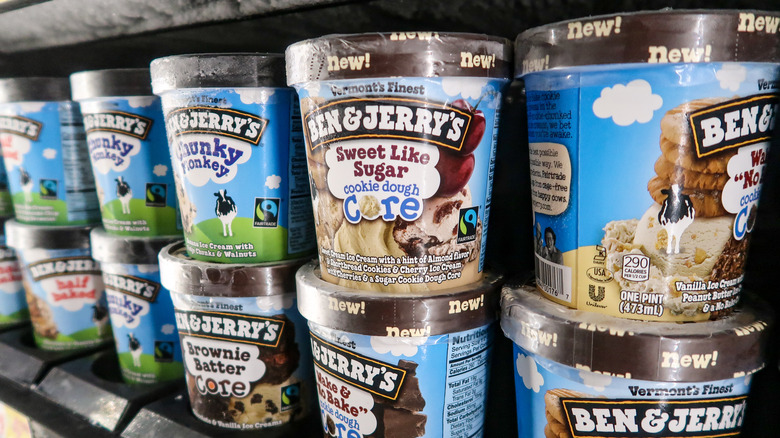How To Choose Premium Ice Creams And Weed Out The Posers
The dairy industry knows that not all ice creams are created equal. Behind the scenes, it categorizes ice cream into four levels of quality: Economy, Standard or Regular, Premium, and Super Premium. But what determines these categories?
The key metric is called "overrun," which measures the volume of air in the ice cream. A typical ice cream base consists of sugar, milk, and cream. If you take a gallon of this base and add enough air to fill out a two-gallon container, that results in 100% overrun. According to Food and Drug Administration guidelines, a product must have less than 100% overrun to call itself ice cream. Economy ice cream only just meets the minimum requirements for the "ice cream" label. These products are often generic-branded, and commonly include artificial colors and flavors. Most ice cream brands found in supermarkets fall into the Standard or Regular category, including major producers like Edy's. These products offer slightly better quality than Economy options in terms of butterfat and overrun.
If you're on the hunt for quality ice cream, targeting the Premium and Super Premium categories is a good strategy. However, there's a catch: these categorizations are an industry standard, not always displayed on the product packaging. Luckily, evaluating an ice cream's weight can be a reliable indicator of its quality — the heavier, the better. Additionally, it's wise to steer clear of misleading labels like "frozen dessert."
How to tell an ice cream's category
Some brands do label their higher-grade products to make them easier to find — after all, "Premium" ice cream has a nice ring to it — but it's understandable why a company might hesitate to mark its products as "Economy."
While it's worth looking for labels like Premium or Super Premium, the absence of these terms doesn't rule out quality. Price can be a clue, as Premium ice cream tends to be more expensive, but this isn't foolproof. Nothing stops Economy brands from trying to sell their products at a higher price, or Premium brands from offering great deals.
A more reliable indicator is weight. A pint of a Premium ice cream will weigh more than a pint of Regular ice cream due to lower overrun — meaning less air is in the mix. If you're puzzled in the freezer aisle, trying to figure it out, remember: The heavier the pint, the more Premium the ice cream.
Brands in the Premium category include Perry's, Baskin-Robbins, Häagen-Dazs, and Ben & Jerry's, with the latter two sometimes classified as Super Premium. For a Super Premium option, consider Straus Family Creamery.
The ice cream label to watch out for
If you're perusing the freezer aisle, keep an eye out for the term "frozen dessert." While these products may look identical to ice cream in both appearance and packaging, they don't meet the FDA's specific guidelines to be classified as ice cream, often lacking the required levels of butterfat or milk solids. This could be a sign that the producer is trying to cut corners by substituting cheaper vegetable fats for dairy, which makes some consumers skeptical about the overall quality of these options.
However, the term "frozen dessert" should not be considered an automatic red flag. Nondairy ice creams, for instance, must use this label because they obviously don't contain butterfat or milk solids. There are numerous high-quality vegan product lines on the market, and some, such as Oatly, are considered to be of pretty darn good quality, despite carrying the "frozen dessert" label.



